Experimental and Theoretical Studies on DNA Binding and Anticancer Activity of Nickel(II) and Zinc(II) Complexes with N– (8–Quinolyl) Salicylaldimine Schiff Base Ligands
Abstract
1. Introduction
2. Materials and Methods
2.1. Materials
2.2. Instruments
2.3. Synthesis of Schiff Base Ligands
2.4. Synthesis of Complexes
2.4.1. Synthesis of Complex [Ni(qsalBr)2] (1)
2.4.2. Synthesis of Complex [Zn(qsalBr)2] (2)
2.4.3. Synthesis of Complex [Ni(qsalBr2)2] (3)
2.5. DFT Calculations
2.6. DNA Binding Study
2.6.1. Electronic Absorption Titration
2.6.2. Fluorescence Titration
2.7. Anticancer Study
2.8. Molecular Docking
3. Results
3.1. IR Spectra
3.2. UV–Vis Absorption Spectra
3.3. Thermogravimetric Analysis (TGA)
3.4. 1H NMR Spectra
3.5. Mass Spectra
3.6. Description of the Molecular Structure
3.7. DFT Investigation
3.7.1. Geometry Optimization of Ligands
3.7.2. Global Reactivity Descriptors
3.8. DNA Binding Study
3.8.1. Electronic Absorption Titrations
3.8.2. FluorescenceTitration
3.9. In Vitro Anticancer Activity
3.10. Molecular Docking
4. Conclusions
Supplementary Materials
Author Contributions
Funding
Data Availability Statement
Acknowledgments
Conflicts of Interest
References
- Zhou, X.Q.; Li, Y.; Zhang, D.Y.; Nie, Y.; Li, Z.J.; Gu, W.; Liu, X.; Tian, J.L.; Yan, S.P. Copper complexes based on chiral Schiff-base ligands: DNA/BSA binding ability, DNA cleavage activity, cytotoxicity and mechanism of apoptosis. EJMECH 2016, 114, 244–256. [Google Scholar] [CrossRef] [PubMed]
- Li, Z.; Niu, M.; Chang, G.; Zhao, C. Chiral manganese (IV) complexes derived from Schiff base ligands: Synthesis, characterization, in vitro cytotoxicity and DNA/BSA interaction. J. Photochem. Photobiol. B 2015, 153, 473–482. [Google Scholar] [CrossRef]
- Jia, A.Q.; Shi, L.M.; Wu, F.; Xin, Z.F.; Zhang, Q.F. Syntheses, structures and immobilization of ruthenium complexes bearing N,O-Schiff-base or N,N′-diamine ligands functionalized with alkoxysilyl groups. J. Organomet. Chem. 2018, 855, 33–43. [Google Scholar] [CrossRef]
- Basak, T.; Ghosh, K.; Gómez-García, C.J.; Chattopadhyay, S. Synthesis, structure and magnetic characterization of a dinuclear and two mononuclear iron(III) complexes with N,O-donor Schiff base ligands. Polyhedron 2018, 146, 42–54. [Google Scholar] [CrossRef]
- Khosravi, I.; Hosseini, F.; Khorshidifard, M.; Sahihi, M.; Rudbari, H.A. Synthesis, characterization, crystal structure and HSA binding of two new N,O,O-donor Schiff-base ligands derived from dihydroxybenzaldehyde and tert-butylamine. J. Mol. Struct. 2016, 1119, 373–384. [Google Scholar] [CrossRef]
- Grzegorczyk, M.; Kapturkiewicz, A.; Sanjuan-Szklarz, F.; Nowacki, J. Monomeric complexes of Re(CO)3+ ion with tridentate N∩N∩O−ligands-Schiff base derivatives of salicylic aldehyde. Inorg. Chem. Commun. 2014, 46, 103–106. [Google Scholar] [CrossRef]
- Li, B.Y.; Yao, Y.M.; Wang, Y.R.; Zhang, Y.; Shen, Q. Synthesis, reactivity and structural characterization of ytterbium complexes bearing a tridentate [O,N,N] Schiff base ligand. Polyhedron 2011, 30, 207–212. [Google Scholar] [CrossRef]
- Sedighipoor, M.; Kianfar, A.H.; Mohammadnezhad, G.; Görls, H.; Plass, W. Unsymmetrical palladium(II) N,N,O,O-Schiff base complexes: Efficient catalysts for Suzuki coupling reactions. Inorganica Chim. Acta 2018, 476, 20–26. [Google Scholar] [CrossRef]
- Ozdemir, O. Synthesis and characterization of a new diimine Schiff base and its Cu2+ and Fe3+ complexes: Investigation of their photoluminescence, conductance, spectrophotometric and sensor behaviors. J. Mol. Struct. 2019, 1179, 376–389. [Google Scholar] [CrossRef]
- Das, R.; Bandyopadhyay, R.; Pramanik, P. Stereo-regulated Schiff base siloxane polymer coated QCM sensor for amine vapor detection. Mater. Chem. Phys. 2019, 226, 214–219. [Google Scholar] [CrossRef]
- Egekenze, R.; Gultneh, Y.; Butcher, R. Catalysis of alkene epoxidation by manganese(II) and (III) complexes of both Schiff base and reduced Schiff base ligands utilizing environmentally benign H2O2. Polyhedron 2018, 144, 198–209. [Google Scholar] [CrossRef]
- Al Zoubi, W.; Ko, Y.G. Organometallic complexes of Schiff bases: Recent progress in oxidation catalysis. J. Organomet. Chem. 2016, 822, 173–188. [Google Scholar] [CrossRef]
- Taha, R.H.; El-Shafiey, Z.A.; Salman, A.A.; El-Fakharany, E.M.; Mansour, M.M. Synthesis and characterization of newly synthesized Schiff base ligand and its metal complexes as potent anticancer. J. Mol. Struct. 2019, 1181, 536–545. [Google Scholar] [CrossRef]
- Bahron, A.; Khaidir, S.S.; Tajuddin, A.M.; Ramasamy, K.; Yamin, B.M. Synthesis, characterization and anticancer activity of mono- and dinuclear Ni(II) and Co(II) complexes of a Schiff base derived from o-vanillin. Polyhedron 2019, 161, 84–92. [Google Scholar] [CrossRef]
- Alexiou, M.; Tsivikas, I.; Dendrinou-Samara, C.; Pantazaki, A.A.; Trikalitis, P.; Lalioti, N.; Kyriakidis, D.A.; Kessissoglou, D.P. High nuclearity nickel compounds with three, four or five metal atoms showing antibacterial activity. J. Inorg. Biochem. 2003, 93, 256–264. [Google Scholar] [CrossRef] [PubMed]
- Luo, W.; Meng, X.; Sun, X.; Xiao, F.; Shen, J.; Zhou, Y.; Cheng, G.; Ji, Z. Synthesis, crystal structure and bioactivity of a novel linear trinuclear nickel(II) complex. Inorg. Chem. Commun. 2007, 10, 1351–1354. [Google Scholar] [CrossRef]
- Ni, Y.N.; Wei, M.; Kokot, S. Electrochemical and spectroscopic study on the interaction between isoprenaline and DNA using multivariate curve resolution-alternating least squares. Int. J. Biol. Macromol. 2011, 49, 622–628. [Google Scholar] [CrossRef]
- Mansouri-Torshizi, H.; I-Moghaddam, M.; Divsalar, A.; Saboury, A. 2,2′-Bipyridine butyldithiocarbamatoplatinum(II) and palladium(II) complexes: Synthesis, characterization, cytotoxicity, and rich DNA-binding studies. Bioorg. Med. Chem. 2008, 16, 9616–9625. [Google Scholar] [CrossRef]
- Tabassum, S.; Ahmad, M.; Afzal, M.; Zaki, M.; Bharadwaj, P.K. Synthesis and structure elucidation of a copper(II) Schiff-base complex: In vitro DNA binding, pBR322 plasmid cleavage and HSA binding studies. J. Photochem. Photobiol. B 2014, 140, 321–331. [Google Scholar] [CrossRef]
- Hartinger, C.G.; Metzler-Nolte, N.; Dyson, P.J. Challenges and Opportunities in the Development of Organometallic Anticancer Drugs. Organometallics 2012, 31, 5677–5685. [Google Scholar] [CrossRef]
- Shahraki, S.; Majd, M.H.; Heydari, A. Novel tetradentate Schiff base zinc(II) complex as a potential antioxidant and cancer chemotherapeutic agent: Insights from the photophysical and computational approach. J. Mol. Struct. 2019, 1177, 536–544. [Google Scholar] [CrossRef]
- Virani, S.; Bilheem, S.; Chansaard, W.; Chitapanarux, I.; Daoprasert, K.; Khuanchana, S.; Leklob, A.; Pongnikorn, D.; Rozek, L.S.; Siriarechakul, S.; et al. National and Subnational Population-Based Incidence of Cancer in Thailand: Assessing Cancers with the Highest Burdens. Cancers 2017, 9, 108. [Google Scholar] [CrossRef] [PubMed]
- Sirirak, J.; Phonsri, W.; Harding, D.J.; Harding, P.; Phommon, P.; Chaoprasa, W.; Hendry, R.M.; Roseveare, T.M.; Adams, H. Halogen substituted quinolylsalicylaldimines: Four halogens three structural types. J. Mol. Struct. 2013, 1036, 439–446. [Google Scholar] [CrossRef]
- Pinchaipat, B.; Khudkham, T.; Wongsuwan, S.; Chotima, R.; Chainok, K.; Pila, T. The novel zinc(II) complex with dibromo substituted Schiff base and its biological activity. Mater. Lett. 2021, 293, 129749. [Google Scholar] [CrossRef]
- Becke, A.D. Density-functional thermochemistry. III. The role of exact exchange. J. Chem. Phys. 1993, 98, 5648–5652. [Google Scholar] [CrossRef]
- Lee, C.; Yang, W.; Parr, R.G. Development of the Colle-Salvetti correlation-energy formula into a functional of the electron density. Phys. Rev. B 1988, 37, 785–789. [Google Scholar] [CrossRef] [PubMed]
- Krishnan, R.; Binkley, J.S.; Seeger, R.; Pople, J.A. Self-consistent molecular orbital methods. XX. A basis set for correlated wave functions. J. Chem. Phys. 1980, 72, 650–654. [Google Scholar] [CrossRef]
- Hay, P.J.; Wadt, W.R. Ab initio effective core potentials for molecular calculations. Potentials for the transition metal atoms Sc to Hg. J. Chem. Phys. 1985, 82, 270–283. [Google Scholar] [CrossRef]
- Promkatkaew, M.; Boonsri, P.; Hannongbua, S. Structural and Spectroscopic Properties of Metal Complexes with Ruhemann’s Purple Compounds Calculated Using Density Functional Theory. Key Eng. Mater. 2019, 824, 204–211. [Google Scholar] [CrossRef]
- Alshaikh, N.E.; Zaki, M.; Sharfalddin, A.A.; Al-Radadi, N.S.; Hussien, M.A.; Hassan, W.M.I. Synthesis, structural characterization, DNA/HSA binding, molecular docking and anticancer studies of some D-Luciferin complexes. Arab. J. Chem. 2023, 16, 104845. [Google Scholar] [CrossRef]
- Frisch, M.J.; Trucks, G.W.; Schlegel, H.B.; Scuseria, G.E.; Robb, M.A.; Cheeseman, J.R. Gaussian 09, Revision A.02; Gaussian, Inc.: Wallingford, CT, USA, 2009. [Google Scholar]
- Geerlings, P.; De Proft, F.; Langenaeker, W. Conceptual Density Functional Theory. Chem. Rev. 2003, 103, 1793–1874. [Google Scholar] [CrossRef] [PubMed]
- Movahedi, E.; Rezvani, A.R. New silver(I) complex with diazafluorene based ligand: Synthesis, characterization, investigation of in vitro DNA binding and antimicrobial studies. J. Mol. Struct. 2017, 1139, 407–417. [Google Scholar] [CrossRef]
- Niu, M.J.; Li, Z.; Chang, G.L.; Kong, X.J.; Hong, M. Crystal Structure, Cytotoxicity and Interaction with DNA of Zinc (II) Complexes with o-Vanillin Schiff Base Ligands. PLoS ONE 2015, 10, e0130922. [Google Scholar] [CrossRef] [PubMed]
- Kazemi, Z.; Rudbari, H.A.; Mirkhani, V.; Sahihi, M.; Moghadam, M.; Tangestaninejad, S.; Mohammadpoor-Baltork, I. Synthesis, characterization, crystal structure, DNA- and HSA-binding studies of a dinuclear Schiff base Zn(II) complex derived from 2-hydroxy naphtaldehyde and 2-picolylamine. J. Mol. Struct. 2015, 1096, 110–120. [Google Scholar] [CrossRef]
- Drew, H.R.; Wing, R.M.; Takano, T.; Broka, C.; Tanaka, S.; Itakura, K.; Dickerson, R.E. Structure of a B-DNA dodecamer: Conformation and dynamics. Proc. Natl. Acad. Sci. USA 1981, 78, 2179–2183. [Google Scholar] [CrossRef] [PubMed]
- Heppner, D.E.; Wittlinger, F.; Beyett, T.S.; Shaurova, T.; Urul, D.A.; Buckley, B.; Pham, C.D.; Schaeffner, I.K.; Yang, B.; Ogboo, B.C.; et al. Structural Basis for Inhibition of Mutant EGFR with Lazertinib (YH25448). ACS Med. Chem. Lett. 2022, 13, 1856–1863. [Google Scholar] [CrossRef] [PubMed]
- Mohamed, G.G.; Omar, M.M.; Hindy, A.M.M. Synthesis, characterization and biological activity of some transition metals with Schiff base derived from 2-thiophene carboxaldehyde and aminobenzoic acid. Spectrochim. Acta Part A 2005, 62, 1140–1150. [Google Scholar] [CrossRef]
- Abd El-Halim, H.F.; Mohamed, G.G.; Khalil, E.A.M. Synthesis, spectral, thermal and biological studies of mixed ligand complexes with newly prepared Schiff base and 1,10-phenanthroline ligands. J. Mol. Struct. 2017, 1146, 153–163. [Google Scholar] [CrossRef]
- Long, E.C.; Barton, J.K. On Demonstrating DNA Intercalation. Acc. Chem. Res. 1990, 23, 271–273. [Google Scholar] [CrossRef]
- Efthimiadou, E.K.; Karaliota, A.; Psomas, G. Metal complexes of the third-generation quinolone antimicrobial drug sparfloxacin: Structure and biological evaluation. J. Inorg. Biochem. 2010, 104, 455–466. [Google Scholar] [CrossRef]
- Mathur, S.; Tabassum, S. Synthesis and characterization of a new macrocyclic copper(II) complex with an N-glycosidic pendant arm: In vitro cytotoxicity and binding studies with calf-thymus DNA. Chem. Biodiversity. 2006, 3, 312–325. [Google Scholar] [CrossRef] [PubMed]
- Alagesan, M.; Bhuvanesh, N.S.P.; Dharmaraj, N. An investigation on new ruthenium(II) hydrazone complexes as anticancer agents and their interaction with biomolecules. Dalton Trans. 2014, 43, 6087–6099. [Google Scholar] [CrossRef] [PubMed]
- Wolfe, A.; Shimer, G.H., Jr.; Meehan, T. Polycyclic aromatic hydrocarbons physically intercalate into duplex regions of denatured DNA. Biochemistry 1987, 26, 6392–6396. [Google Scholar] [CrossRef]
- Yilmaz, V.T.; Gocmen, E.; Icsel, C.; Cengiz, M.; Susluer, S.Y.; Buyukgungor, O. Di- and polynuclear silver(I) saccharinate complexes of tertiary diphosphane ligands: Synthesis, structures, in vitro DNA binding, and antibacterial and anticancer properties. J. Biol. Inorg. Chem. 2014, 19, 29–44. [Google Scholar] [CrossRef] [PubMed]
- Wang, Q.; Yang, Y.Z.; Qi, G.F.; Qin, D.D. Synthesis, crystal structure, antioxidant activities and DNA-binding studies of the Ln(III) complexes with 7-methoxychromone-3-carbaldehyde-(4'-hydroxy) benzoyl hydrazone. EJMECH 2009, 44, 2425–2433. [Google Scholar] [CrossRef] [PubMed]
- Sujatha, S.; Balasubramanian, S.; Varghese, B.; Jayaprakashvel, M.; Mathivanan, N. Synthesis, characterization and DNA interaction of hexaaza macrotricyclic copper(II) complexes. Inorganica Chim. Acta 2012, 386, 109–115. [Google Scholar] [CrossRef]
- Vikneswaran, R.; Eltayeb, N.E.; Ramesh, S.; Yahya, R. New alicyclic thiosemicarbazone chelated zinc(II) antitumor complexes: Interactions with DNA/protein, nuclease activity and inhibition of topoisomerase-I. Polyhedron 2016, 5, 89–95. [Google Scholar] [CrossRef]
- Haribabu, J.; Sabapathi, G.; Tamizh, M.M.; Balachandran, C.; Bhuvanesh, N.S.P.; Venuvanalingam, P.; Karvembu, R. Water-Soluble Mono- and Binuclear Ru(η6-p-cymene) Complexes Containing Indole Thiosemicarbazones: Synthesis, DFT Modeling, Biomolecular Interactions, and In Vitro Anticancer Activity through Apoptosis. Organometallics 2018, 37, 1242–1257. [Google Scholar] [CrossRef]

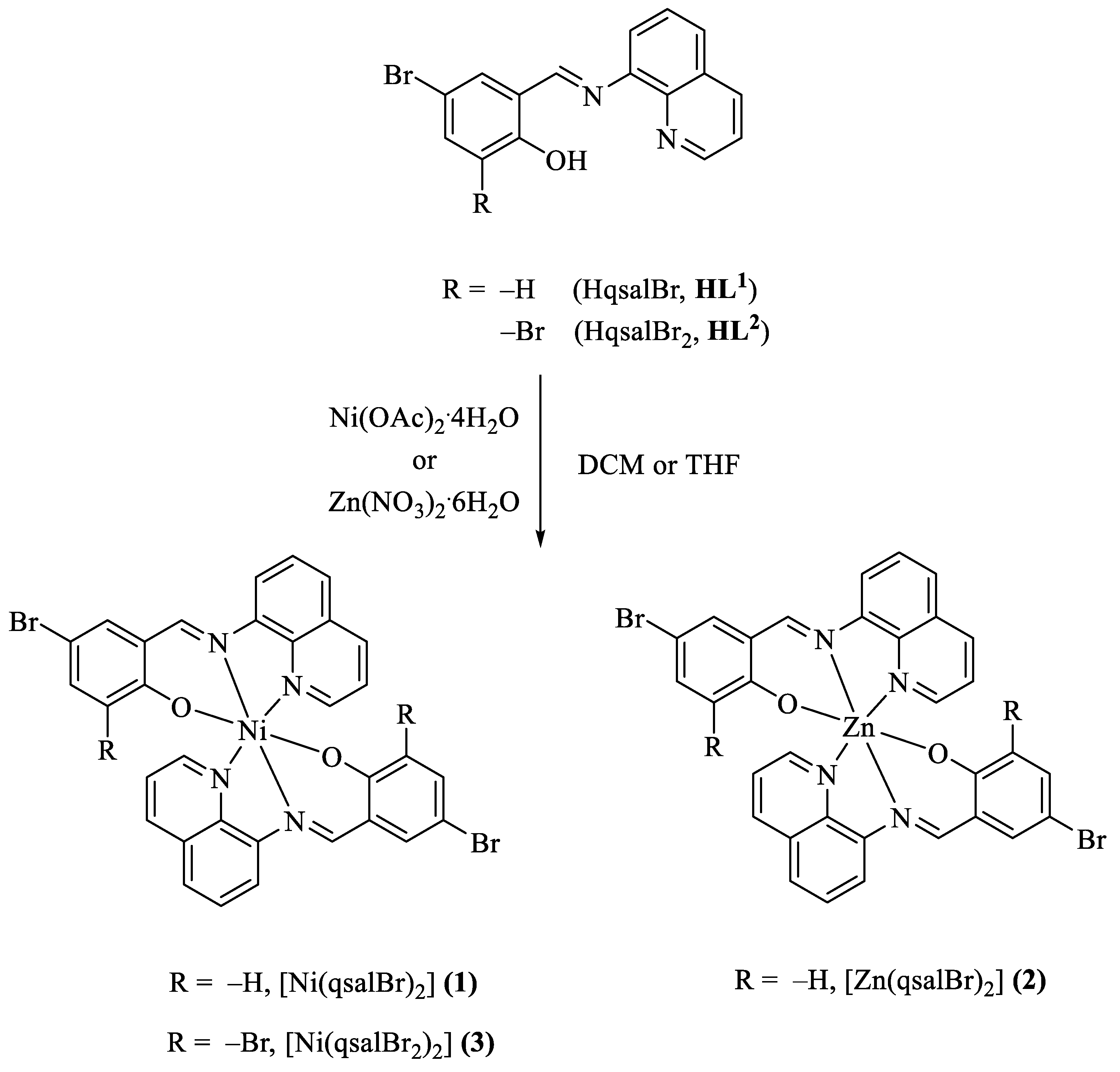
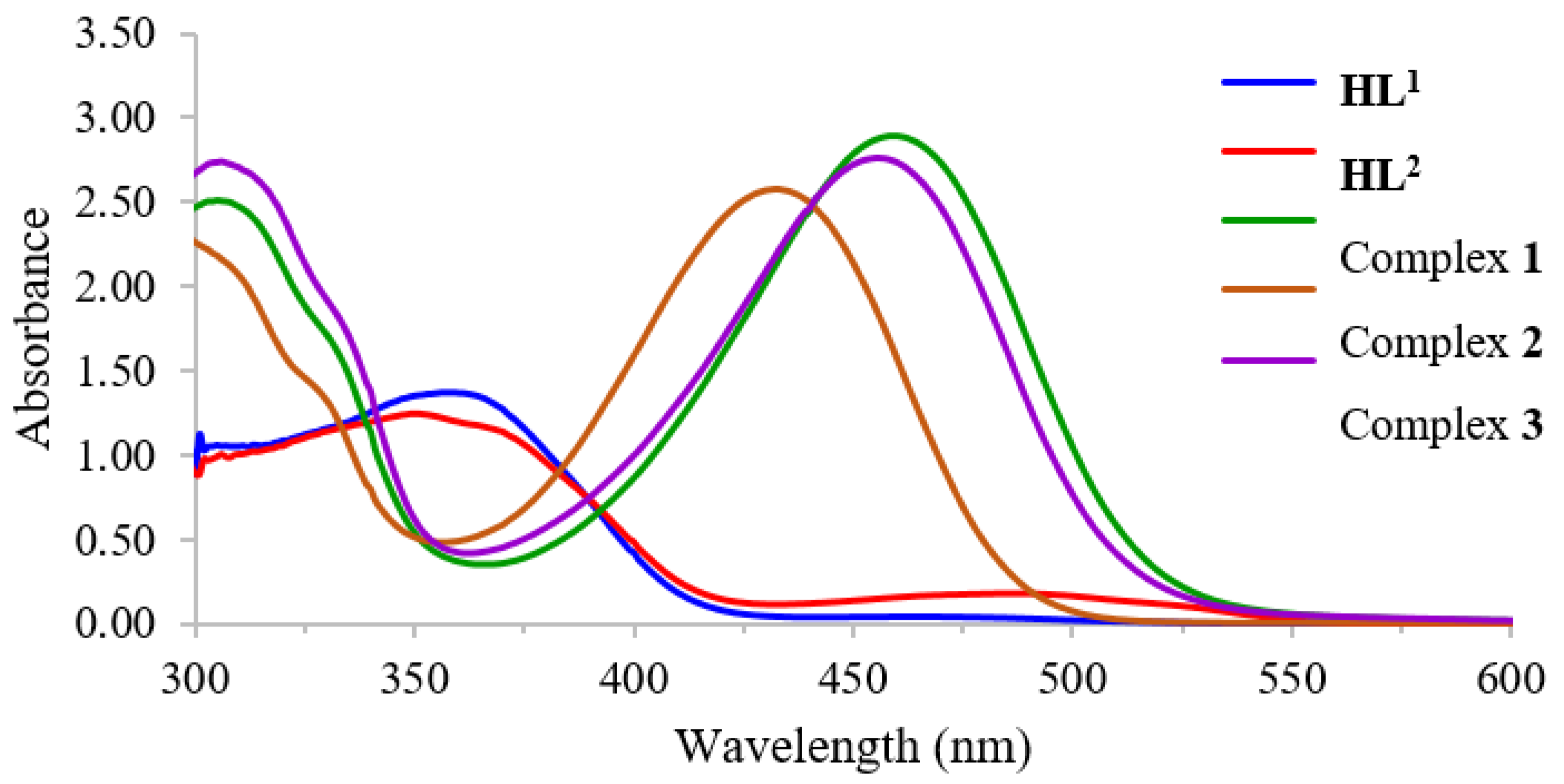

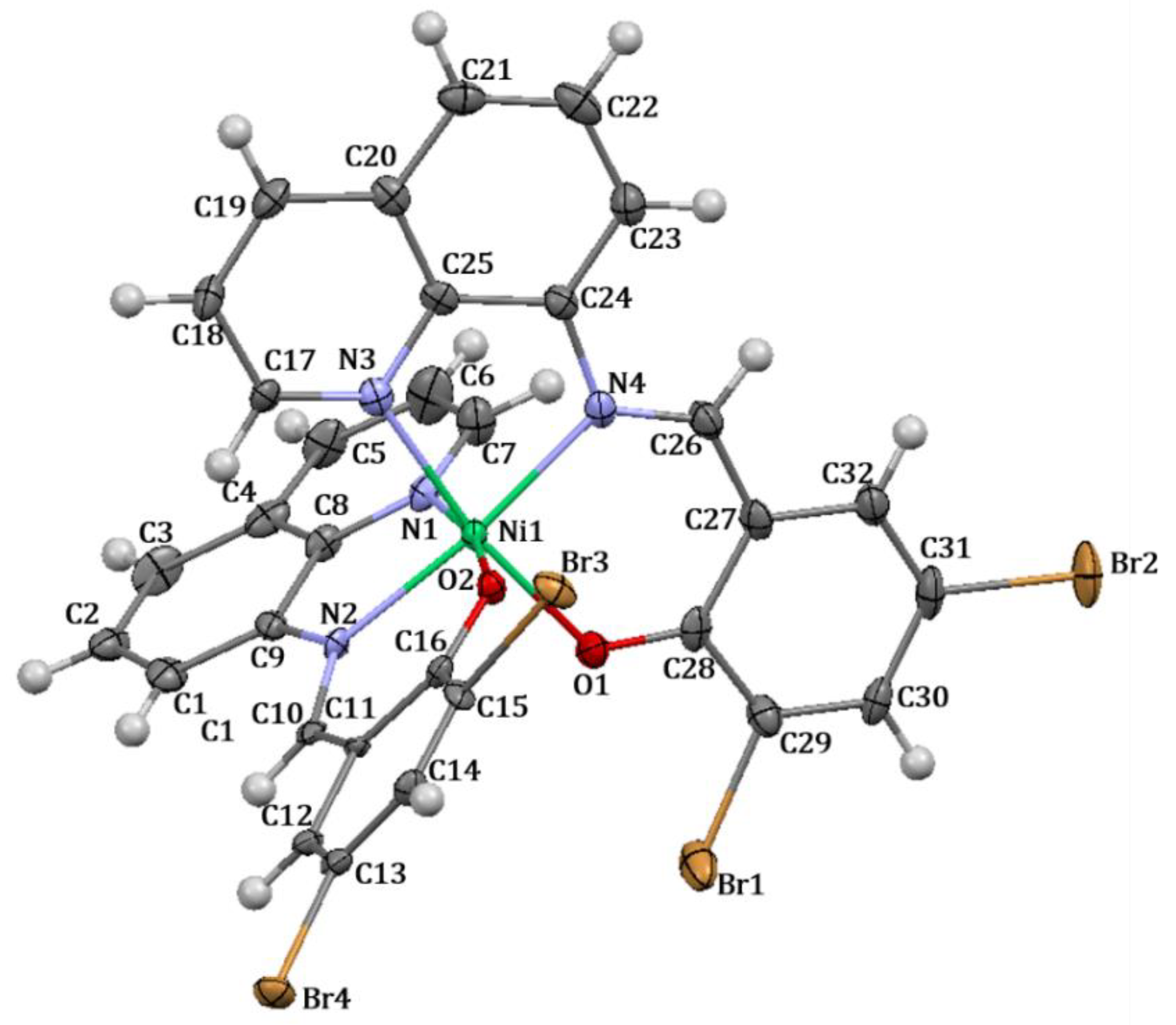
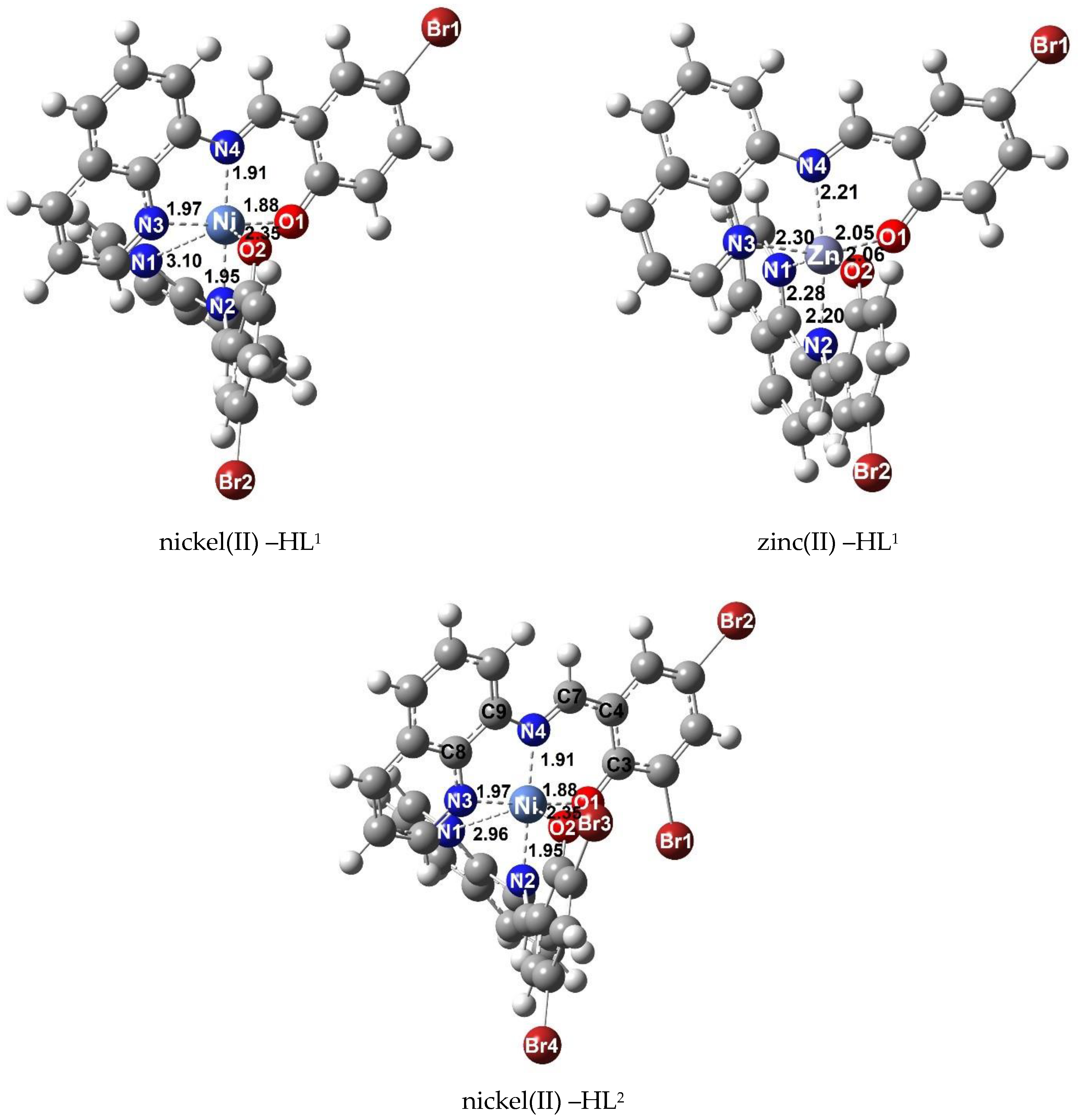
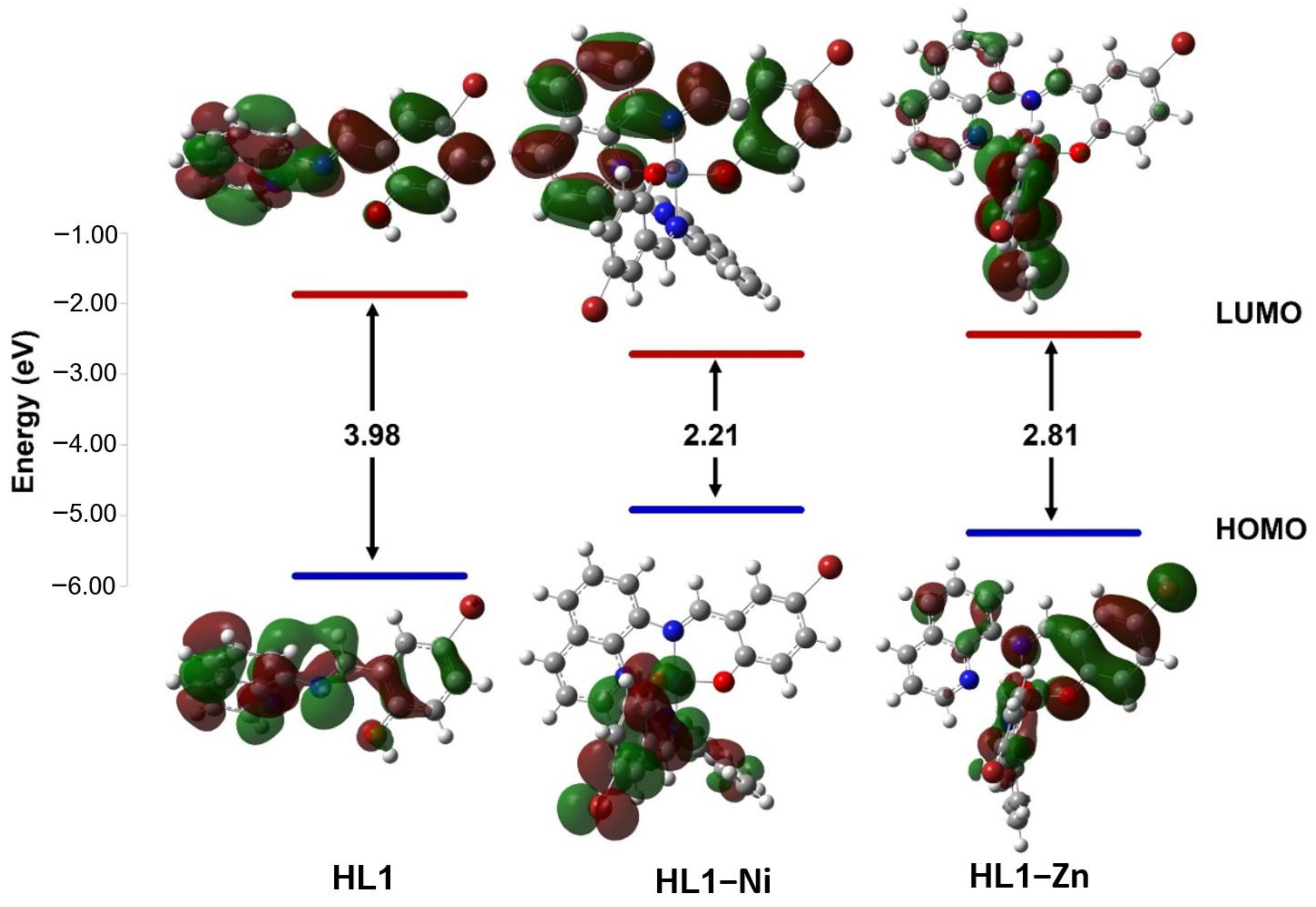

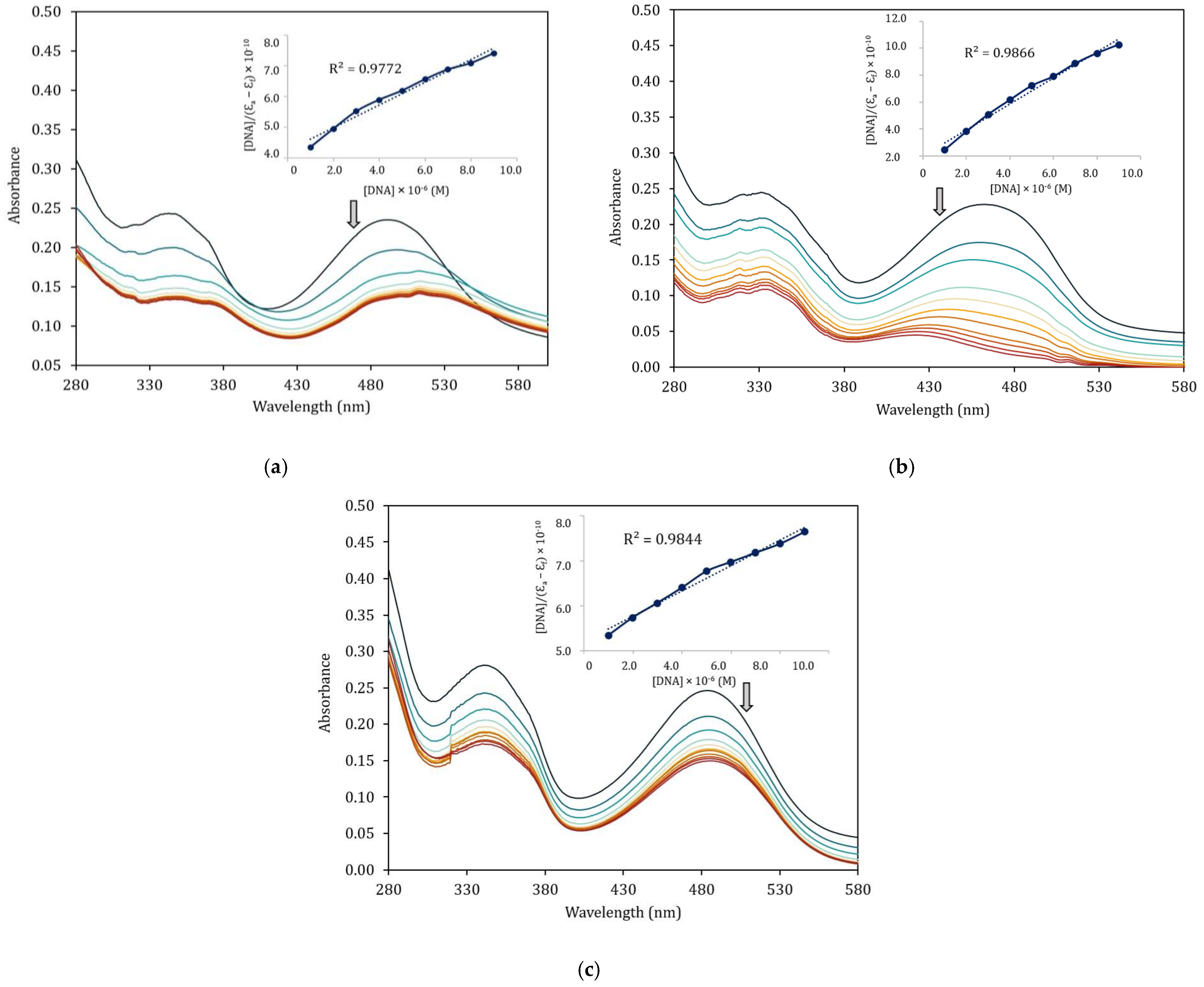


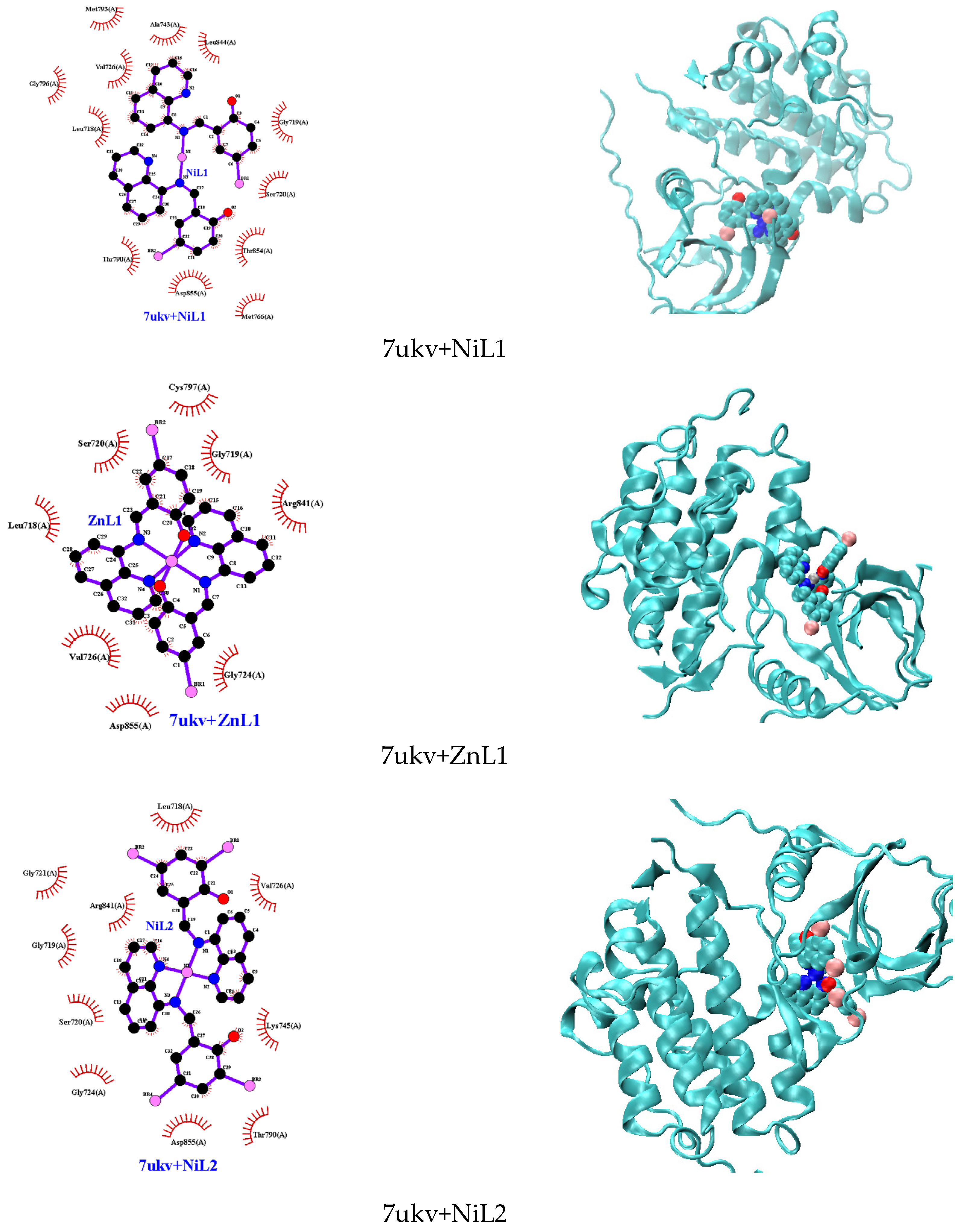
| Compounds | IR (cm−1) | ||||
|---|---|---|---|---|---|
| ν(C=N) | ν(C–O) | ν(C=N) (Quinoline) | ν(M–O) | ν(M–N) | |
| HqsalBr (HL1) | 1606 | 1282 | 1423 | - | - |
| HqsalBr2 (HL2) | 1607 | 1283 | 1425 | - | - |
| [Ni(qsalBr)2] (1) | 1603 | 1231 | 1417 | 470 | 419 |
| [Zn(qsalBr)2] (2) | 1605 | 1234 | 1415 | 468 | 416 |
| [Ni(qsalBr2)2] (3) | 1604 | 1240 | 1413 | 489 | 426 |
| Compounds | Color (Solid) | Color (Solution) | λmax (nm), ɛ (M−1cm−1) | Formation Constant |
|---|---|---|---|---|
| HqsalBr (HL1) | Orange | Pale yellow | 357 (12,428) | - |
| HqsalBr2 (HL2) | Red | Pale yellow | 351 (13,732) | - |
| [Ni(qsalBr)2] (1) | Brown | Deep orange | 484 (20,545) | 2.52 × 106 |
| [Zn(qsalBr)2] (2) | Orange | Light orange | 460 (15,690) | 5.67 × 105 |
| [Ni(qsalBr2)2] (3) | Brown | Deep orange | 487 (14,810) | 8.69 × 105 |
| Compounds | TG Range (°C) | Weight Loss Exp. (Calcd.)% | Total Weight Loss Exp. (Calcd.)% | Assignment | Residue |
|---|---|---|---|---|---|
| [Ni(qsalBr)2] (1) C32H20Br2N4NiO2 | 138–467 467–685 685–1000 | 22.64 (22.89) 20.48 (19.78) 43.37 (42.40) | 86.49 (85.07) | Br2 C9H2NO C20H18N3 | NiO, C atom |
| [Zn(qsalBr)2] (2) C32H20Br2N4ZnO2 | 137–466 466–682 682–1000 | 22.22 (22.11) 20.83 (19.62) 41.59 (42.08) | 84.64 (83.81) | Br2 C9H2NO C20H18N3 | ZnO, C atom |
| [Ni(qsalBr2)2] (3) C32H18Br4N4NiO2 | 137–467 467–575 575–1000 | 36.33 (36.54) 27.92 (28.72) 35.75 (34.74) | 100 (100) | Br4 C18H4N2 C14H14N2O2Ni | - |
| Crystal Data | Complex 3 |
|---|---|
| Compound | [Ni(qsalBr2)2] |
| Empirical formula | C32H18Br4N4NiO2 |
| Formula weight | 868.83 |
| Temperature/K | 100.01 |
| Crystal system | monoclinic |
| Space group | P21/c |
| a/Å | 21.8302 (12) |
| b/Å | 10.1217 (6) |
| c/Å | 13.4878 (8) |
| α/° | 90 |
| β/° | 103.808 (2) |
| γ/° | 90 |
| Volume/Å3 | 2894.1 (3) |
| Z | 4 |
| ρcalc g/cm3 | 1.9939 |
| μ/mm−1 | 6.232 |
| F (000) | 1685.8 |
| Crystal size/mm3 | 0.63 × 0.62 × 0.13 |
| Radiation | MoKα (λ = 0.71073) |
| 2Θ range for data collection/° | 4.46 to 51.56 |
| Index ranges | −26 ≥ h ≥ 26, −12 ≥ k ≥ 12, −16 ≥ l ≥ 16 |
| Reflections collected | 54,704 |
| Independent reflections | 5542 [Rint = 0.1105, Rsigma = 0.0519] |
| Data/restraints/parameters | 5542/0/388 |
| Goodness-of-fit on F2 | 1.096 |
| Final R indexes [I ≥ 2σ (I)] | R1 = 0.0532, wR2 = 0.0942 |
| Final R indexes [all data] | R1 = 0.0744, wR2 = 0.1008 |
| Largest diff. peak/hole/e Å−3 | 1.27/−1.27 |
| Bond Lengths [Å] | Ligand HL2 | Complex 3 | Bond Angles [°] | Ligand HL2 | Complex 3 | Torsion Angles [°] | Ligand HL2 | Complex 3 |
|---|---|---|---|---|---|---|---|---|
| C8−C9 | 1.431 (3) | 1.437 (8) | C15−C16−C11 | 115.0 (2) | 114.3 (6) | C11−C10−N2−C9 | 178.0 (2) | 168.7 (6) |
| C11−C16 | 1.447 (2) | 1.427 (9) | C16−C11−C10 | 120.4 (2) | 124.9 (6) | C9−C8−N1−C7 | −178.6 (2) | 176.8 (6) |
| C15−C16 | 1.437 (3) | 1.43 (1) | C12−C11−C10 | 118.1 (2) | 114.1 (5) | N1−C8−C4−C3 | 178.4 (2) | 176.8 (6) |
| O2−C16 | 1.280 (2) | 1.275 (7) | C10−N2−C9 | 127.1 (2) | 120.0 (5) | C13−C12−C11−C10 | 177.2 (2) | 175.1 (6) |
| N2−C9 | 1.416 (3) | 1.424 (9) | C7−N1−C8 | 117.2 (2) | 119.0 (6) | C10−N2−C9−C1 | 3.8 (3) | 15 (1) |
| N2−C10 | 2.312 (2) | 1.316 (8) | N2−C9−C8 | 115.4 (2) | 114.3 (5) | C15−C14−C13−C12 | −0.3 (4) | −3 (1) |
| N1−C7 | 1.318 (3) | 1.322 (8) | N1−C8−C4 | 118.2 (2) | 118.3 (6) | N1−C8−C9−N2 | 1.8 (3) | −0.7 (8) |
| N1−C8 | 1.367 (3) | 1.351 (9) | N2−C9−C1 | 123.7 (2) | 126.3 (6) | |||
| O2−C16−C11 | 122.1 (2) | 125.7 (6) | ||||||
| O2−C16−C15 | 123.0 (2) | 119.9 (6) |
| eV | EH | EL | ΔE | η | S | μ | χ | ω |
|---|---|---|---|---|---|---|---|---|
| HL1 | −5.86 | −1.87 | 3.98 | 1.99 | 185.82 | −3.87 | 3.87 | 3.75 |
| HL1–Ni | −4.92 | −2.71 | 2.21 | 1.10 | 335.41 | −3.82 | 3.82 | 6.60 |
| HL1–Zn | −5.25 | −2.44 | 2.81 | 1.41 | 263.50 | −3.84 | 3.84 | 5.25 |
| HL2 | −5.97 | −2.06 | 3.91 | 1.95 | 189.49 | −4.01 | 4.01 | 4.12 |
| HL2–Ni | −5.10 | −2.88 | 2.22 | 1.11 | 332.91 | −3.99 | 3.99 | 7.15 |
| Complexes | Kb (M−1) | Ksv (M−1) | Kq (M−1 s−1) |
|---|---|---|---|
| [Ni(qsalBr)2] (1) | 1.13 × 106 | 1.78 × 104 | 7.74 × 1011 |
| [Zn(qsalBr)2] (2) | 4.82 × 106 | 2.00 × 104 | 8.70 × 1011 |
| [Ni(qsalBr2)2] (3) | 6.02 × 105 | 1.66 × 104 | 7.22 × 1011 |
| Compound | IC50 (µM) | Compound | IC50 (µM) |
|---|---|---|---|
| HL1 | N/A a | [Ni(qsalBr)2] (1) | 258.43 ± 6.25 |
| HL2 | N/A | [Zn(qsalBr)2] (2) | 88.59 ± 5.90 |
| Etoposide | 18.61 ± 1.25 | [Ni(qsalBr2)2] (3) | 315.00 ± 9.20 |
| Cisplatin [49] | 21.3 |
| Compound | Binding Energy (kcal/mol) | |
|---|---|---|
| 1bna | 7ukv | |
| HL1 | −8.0 | 7ukv |
| HL2 | −7.7 | −7.8 |
| [Ni(qsalBr)2] (1) | −7.8 | −7.2 |
| [Zn(qsalBr)2] (2) | −8.7 | −9.0 |
| [Ni(qsalBr2)2] (3) | −9.1 | −8.6 |
| ZRT (Lazertinib) | – | −9.3 |
Disclaimer/Publisher’s Note: The statements, opinions and data contained in all publications are solely those of the individual author(s) and contributor(s) and not of MDPI and/or the editor(s). MDPI and/or the editor(s) disclaim responsibility for any injury to people or property resulting from any ideas, methods, instructions or products referred to in the content. |
© 2024 by the authors. Licensee MDPI, Basel, Switzerland. This article is an open access article distributed under the terms and conditions of the Creative Commons Attribution (CC BY) license (https://creativecommons.org/licenses/by/4.0/).
Share and Cite
Pinchaipat, B.; Chotima, R.; Promkatkaew, M.; Kitjaruwankul, S.; Chainok, K.; Khudkham, T. Experimental and Theoretical Studies on DNA Binding and Anticancer Activity of Nickel(II) and Zinc(II) Complexes with N– (8–Quinolyl) Salicylaldimine Schiff Base Ligands. Chemistry 2024, 6, 618-639. https://doi.org/10.3390/chemistry6040037
Pinchaipat B, Chotima R, Promkatkaew M, Kitjaruwankul S, Chainok K, Khudkham T. Experimental and Theoretical Studies on DNA Binding and Anticancer Activity of Nickel(II) and Zinc(II) Complexes with N– (8–Quinolyl) Salicylaldimine Schiff Base Ligands. Chemistry. 2024; 6(4):618-639. https://doi.org/10.3390/chemistry6040037
Chicago/Turabian StylePinchaipat, Bussaba, Ratanon Chotima, Malinee Promkatkaew, Sunan Kitjaruwankul, Kittipong Chainok, and Teerawat Khudkham. 2024. "Experimental and Theoretical Studies on DNA Binding and Anticancer Activity of Nickel(II) and Zinc(II) Complexes with N– (8–Quinolyl) Salicylaldimine Schiff Base Ligands" Chemistry 6, no. 4: 618-639. https://doi.org/10.3390/chemistry6040037
APA StylePinchaipat, B., Chotima, R., Promkatkaew, M., Kitjaruwankul, S., Chainok, K., & Khudkham, T. (2024). Experimental and Theoretical Studies on DNA Binding and Anticancer Activity of Nickel(II) and Zinc(II) Complexes with N– (8–Quinolyl) Salicylaldimine Schiff Base Ligands. Chemistry, 6(4), 618-639. https://doi.org/10.3390/chemistry6040037





_CHAINOK.jpg)


